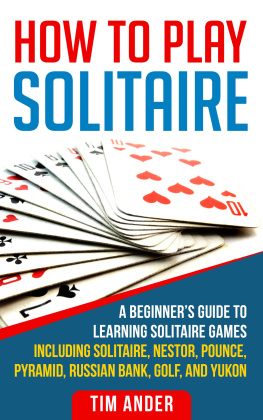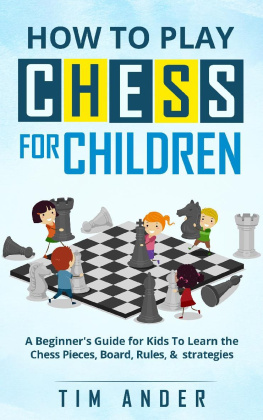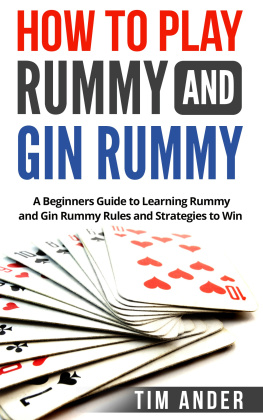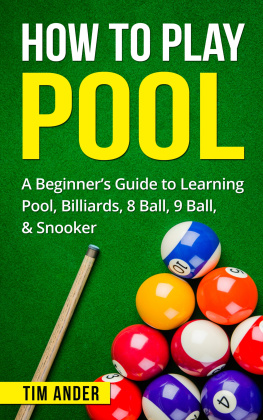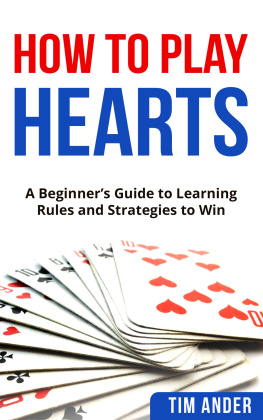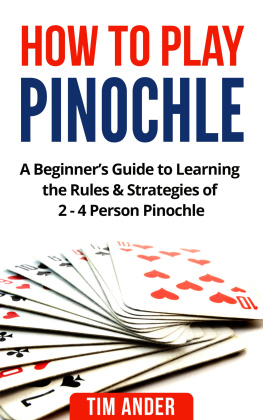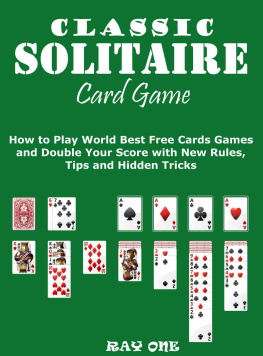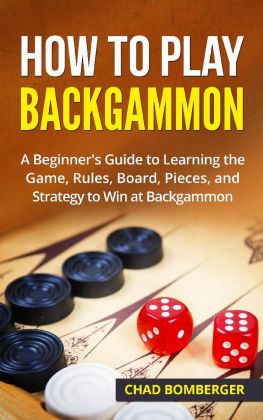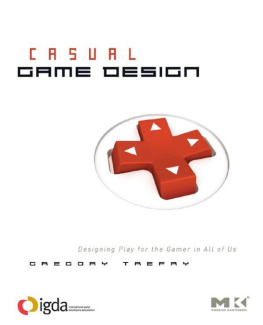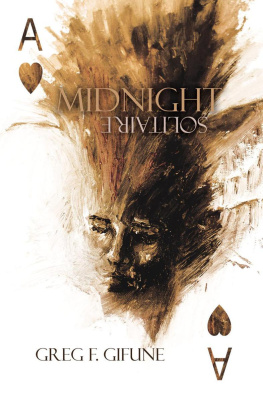How to play
SOLITAIRE
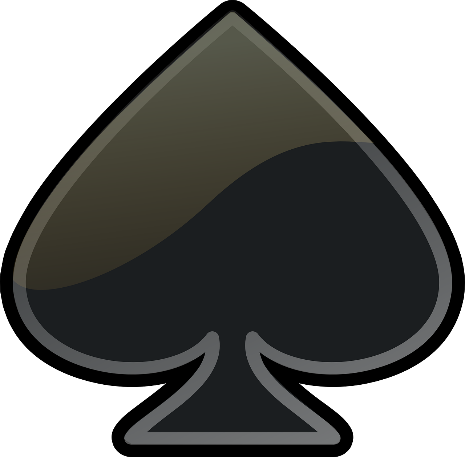
Tim Ander
Copyright 2018 by Tim Ander.
All rights reserved.
No part of this publication may be reproduced, distributed, or transmitted in any form or by any means, including photocopying, recording, or other electronic or mechanical methods, without the prior written permission of the publisher, except in the case of brief quotations embodied in critical reviews and certain other noncommercial uses permitted by copyright law.
For permission requests, please write to the publisher
Table of Contents
Introduction
What Is Solitaire?
Solitaire is a card game for one. In North America, it is generally referred to as Solitaire. In the UK it is referred to as Patience. There are other names in other places, but the play of the game is the same. There are two player versions, but traditionally Solitaire is a one-player game.
The game is played with a regular deck of cards and a flat playing surface. The cards are shuffled and dealt into a predetermined arrangement. From here, the goal is to sort the cards into an order, with the goal usually being to arrange the cards into piles, by suit. The moves allowed in the game of Solitaire are dependant on the variation played, but usually, a card of a lower rank and different color suit can be played on another card.
Cards are arranged into columns in this way, with cards being moved to suited piles toward the endgame. The gameplay is hard to explain in a few short sentences, but we will be delving deeper into how to play. For now, we will be happy with knowing the basic mechanics of the game and imagine how they fit together.
One of the great things about Solitaire is that once you know the basic mechanics, you can launch yourself into the variations. There are numerous variations, but most of them follow similar gameplay. I love to play card games, especially with friends. The thing I love about Solitaire is that you do not need to have anyone else to play. Playing with friends is great, but there are times when you will not have anyone to play with. In these situations, Solitaire is a great game to challenge yourself and fill your time. If you have a deck of cards, you can play Solitaire.
History of Solitaire
Solitaire is not an old game, as far as some card games go, but it has been around for a long time. For a time, Solitaire was believed to be able to predict the future. The arrangement of cards became caught up in cartomancy, and the word Kabal, meaning all-knowing, was used as a variation of the games title. There is a written mention of the game in the mid-1700s.
It is thought that Scandinavia is where the game originated, but there are also signs pointing to Germany as the birthplace too. From one of these places, the game moved to France in the early 19th century. This is where the popularity began to grow. From France, the game moved to the England and America. Now, it is a game which is played all over the world, and the variations are too numerous to count. I do not see the game stopping anytime soon, and I am sure that further variation will develop as time passes.
How to Play Solitaire
Getting Started
What do you need for a game of Solitaire? You need a regular deck of cards. You need yourself. You need a playing surface (for regular solitaire a tabletop will do). You need some snacks and drinks. Well, you do not need snacks and drinks, but it is so much more fun with them.
The Deal
Solitaire uses a regular deck of 52 cards. In Solitaire the cards are ranked from K (high) to A (low) as follows: K, Q, J, 10, 9, 8, 7, 6, 5, 4, 3, 2, A. Solitaire also makes use of the four suits: diamonds, hearts, spades, and clubs. We will talk about that later. Before you deal the cards, you should make sure that the cards are well shuffled. This makes more of a difference after playing a game of Solitaire, as the cards will be in a certain order.
Once you have shuffled the cards, you can deal. When dealing, it is important to make space for four groupings of cards. You will deal the first grouping in the center of your playing area, leaving space between the cards and yourself for other cards to be added. The first grouping is known as the tableau. The tableau is a group of seven piles of cards which make up the main playing area of the game. The seven piles cards sit side by side.
To deal the tableau, first, place a card face up on the playing surface. This card should be on the left-hand side of your playing surface. This card is pile 1. Next, deal six more cards. These cards will be dealt face down, and each card will form a separate pile. You should now have seven cards on the table. The first card will be face-up, and the other six will be face-down. You should leave a slight gap between each pile. From left to right, you will have pile 1, pile 2, pile 3, pile 4, pile 5, pile 6, and pile 7. But, the deal is not yet over.
To form the seven piles, you dealt seven cards. Next, you will deal six more cards. Pile 2 will be dealt a face-up card on top. Piles 3-7 will be dealt a face-down card on each pile. Now, pile 3 will be dealt a face-up card with piles 4-7 dealt a face-down card. Next, pile 4 will be dealt a face-up card with piles 5-7 dealt a face-down card. Then pile 5 will be dealt a face-up card, and the remaining two piles will be dealt a face-down card. Pile 6 will then get a face-up card and pile seven a face-down card. Lastly, pile 7 will be dealt a face-up card. The Tableau is now complete.
To recap, we should now have 7 piles of cards. Each pile will have the following cards:
Pile 1: 1 face-up card.
Pile 2: 1 face-up card on top of 1 face-down card.
Pile 3: 1 face-up card on top of 2 face-down cards.
Pile 4: 1 face-up card on top of 3 face-down cards.
Pile 5: 1 face-up card on top of 4 face-down cards.
Pile 6: 1 face-up card on top of 5 face-down cards.
Pile 7: 1 face-up card on top of 6 face-down cards.
The next pile to deal is the hand (or stock) pile. To do this, you simply place the remainder of the deck somewhere on the bottom left of your playing area. There are no further cards to deal. There are two remaining piles, but these will come into play as the game begins and we will discuss them then. For now, we have our tableau dealt and our stock pile.
The Play
Once the tableau and stock pile have been dealt, we can begin to play. The aim of the game is to transfer all of the cards from the stock pile and the tableau into the foundation piles (which we will talk about soon). The cards in the tableau can be moved to one of two places. Lets talk about moving them within the tableau. As you can see from the deal, there are some cards hidden under the face-up cards on each pile. It is beneficial to uncover these cards. This will give us more options for moving cards around.
To move cards in the tableau, there are some rules to follow. At the moment we have seven cards face-up. This means that we can only move one card at a time. When you move a card, you place it on another face-up card but shifted downward slightly so that the card below can be seen. There are also two rules to follow when deciding if you can move a card onto another. The card which you are moving must be one rank below the one you are moving it to, and it must be of a differently colored suit.
If you have a 5 of hearts as a face-up card, you could legally move this onto a 6 (ranked one higher) of clubs (different color suit) or spades (different color suit). You could not move it onto a 6 of diamonds (same color suit) or a 7 of clubs (ranked two higher). In this way, you will start to build up columns of cards which descend in rank and alternate in color. What else do you need to think about?
Next page
